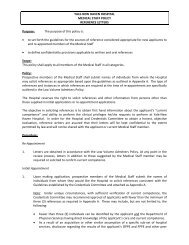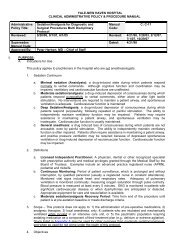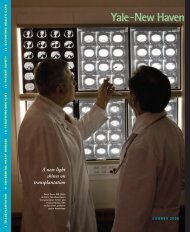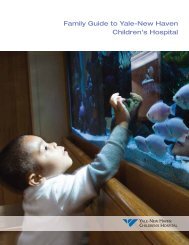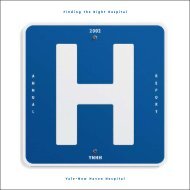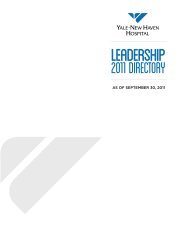Observers - Yale-New Haven Hospital
Observers - Yale-New Haven Hospital
Observers - Yale-New Haven Hospital
Create successful ePaper yourself
Turn your PDF publications into a flip-book with our unique Google optimized e-Paper software.
MEDICAL WASTE CLASSIFICATION AND SEPARATION REFERENCE CHART<br />
The following items are MEDICAL WASTE:<br />
The following items are NOT MEDICAL WASTE<br />
unless visibly dripping waste blood.<br />
1. SHARPS: to be deposited into the designated needle disposal containers. Dispose in ordinary waste containers:<br />
BLADES, GLASS SLIDES, GLASS TUBES<br />
NEEDLES- IV, HYPODERMIC, SPINAL, SUTURE<br />
LANCETS, PROBES, SAFETY PINS, SHEARS, SCRAPPERS, SCISSORS<br />
SYRINGES WITH OR WITHOUT NEEDLE, VACUTAINERS EMPTY SPECIMEN CONTAINERS<br />
GLASS MEDICATION VIALS DRESSINGS, GAUZE, 3 X 4 PADS, ETC.<br />
CHUX, SWABS, SPLINTS<br />
2. VISIBLY DRIPPING WASTE BLOOD: contain fluids where possible MASKS, GLOVES, GOWNS<br />
and deposit any items saturated with visibly dripping blood in TAPE, PADS, COTTON<br />
regulated waste container. SUTURES- without attached needle<br />
INFECTIOUS WASTE CEREBROSPINAL AND PLEURAL FLUIDS: RESPIRATORY SUCTION TUBING<br />
Void container of fluids where possible and deposit containers and/or VENTILATOR TUBING<br />
sealed units in regulated waste containers. FOLEY BAGS, FOLEY CATHETERS<br />
OR SPONGES, SUCTION TUBING & CANISTER LINERS, RED RUBBER CATHETERS<br />
OTHER SUCTION TUBING CONTAINING BLOOD, PLEUREVACS, HEMOVACS BED PANS, EMESIS BASINS<br />
BLOOD TRANSFUSION & PHERESIS FILTERS, TUBING & BAGS DIAPERS<br />
HEMODIALYSIS & CVVH FILTERS & TUBING URINALS, TOILET HATS<br />
1 LITER GLASS VACCUM BOTTLES (USED TO REMOVE ASCITES) PERI (OB) PADS<br />
SPECIMEN CONTAINERS (MOSTLY FROM LABS) SALEM SUMP (NG) TUBES<br />
IRRIGATION SETS, BULB SYRINGES<br />
3. ALL WASTE FROM BIOSAFETY LEVEL 4 AGENTS: All waste from a person PAPER TOWELS, TISSUES, CUPS<br />
with biosafety level 4 disease, such as viral hemorrhagic fever. PACKAGING MATERIALS<br />
CASTS, CAST PADDING<br />
4. CULTURES AND STOCKS of agents infectious to humans and associated PLASTIC MEDICATION VIALS<br />
biologicals including cultures from medical, clinical and hospital PERITONEAL DIALYSIS BAGS & TUBING<br />
laboratories; culture dishes and devices used to transfer, inoculate,<br />
or mix cultures<br />
5. RESEARCH ANIMAL WASTE which includes contaminated animal carcasses, Remove all needles from tubing and if the tubing is NOT visibly dripping<br />
waste blood, deposit animal bedding or animals that were intentionally exposed to tubing in ordinary waste container<br />
infectious agents during research.<br />
6. PATHOLOGICAL WASTE means any human tissue, organ or body part Empty fluid from all used/unused IV containers when possible,<br />
removed during surgery, autopsy or other medical procedure (waste to be then place in ordinary waste container.<br />
segregated in corrugated boxes).<br />
7. CHEMOTHERAPY WASTE IV bags containing less than 3% of antineoplastic Place all glass IV fluid containers into glass-only containers<br />
agents can be deposited directly into medical waste containers. Any IV If you need a glass-only container, contact Environmental Services.<br />
bag containing unused antineoplastic agents over 3% must be returned to<br />
Pharmacy for placement in special corrugated containers and disposed of<br />
as hazardous waste by incineration.<br />
Page the Nursing Education specialist or Clinical Advisor, or phone Epidemiology at 8-4634 with questions concerning medical waste classification or separation. <br />
Phone Environmental Services at 8-6688 with questions about medical waste containers or pick-up schedule. <br />
14


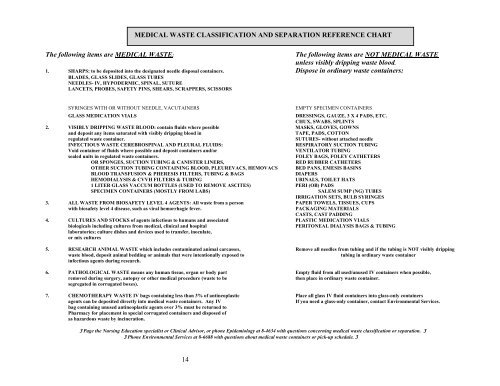



![Annual Report Donor Listings [pdf] - Yale-New Haven Hospital](https://img.yumpu.com/49673575/1/190x245/annual-report-donor-listings-pdf-yale-new-haven-hospital.jpg?quality=85)

